Goa is abuzz with excitement as vintage bike and car owners, users, collectors and fans are decking […]
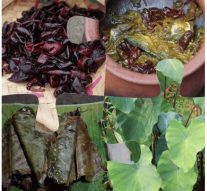
REDISCOVERING TRIBAL CUISINE OF GOA… Presented by Govt College of Art, Science & Commerce, Quepem
Aug 16- Aug 22, 2025, MIND & BODY, HEART & SOUL August 15, 2025What is tribal cuisine all about? It is worth finding out! Students and staff of the Government College of Arts, Science and Commerce, Quepem decided to find out and came up with some amazing discoveries. The study project was undertaken with the support of the Ministry of Tribal Affairs, Government of India, and in collaboration with the Tribal Research Institute Scheme.
The project commenced on June 1, 2023 with the aim of exploring, documenting and celebrating the rich culinary heritage of Goa’s tribal communities, namely the Gawada, Velip and Kunbi people who to this day continue to practice their age-old ways of food preparation and preservation.
Goa is globally known for its coastal seafood and Portuguese-influenced cuisine; but here is cuisine which reflects a deeper, more sustainable and ancestral connection to the land. Here are simple insights into preparing food with practical minimalism, resourcefulness and at the same time living in harmony with the yielding earth if treated with respect and affection.
The project yielded as many as 75 traditional recipes, using locally sourced ingredients such as forest vegetables, tubers, fruits, freshwater fish, etc. It is time to showcase a tribal people’s deep rooted knowledge and connection with village life, making the most of locally farmed and forest produce, and offering invaluable guidance for those of us addicted to modern industrial foods detrimental to mind and body, heart and soul!
Endorsing all this is officiating principal Dr Pravina Kerkar of the Government College of Arts, Science & Commerce, Quepem, who reiterates, “ By exploring traditional tribal food practices, this project not only showcases indigenous culinary wisdom but also brings to light the sustainable and health-conscious lifestyles of our tribal communities.”
The research team comprised of principal investigator Dr Priyanka Malik nee Velip, co-investigators Prof Mehtab Bhukhari and Prof Sushila Mendes, research assistant Ramita Gaonkar and Gaurav Zalmi.
We cannot do better than take pleasure in reproducing a selection of some of the primary recipes yielded by this fascinating project.
Note: Please note that all servings may be adjusted at the discretion of whoever is preparing a recipe.
BONI BHAJI
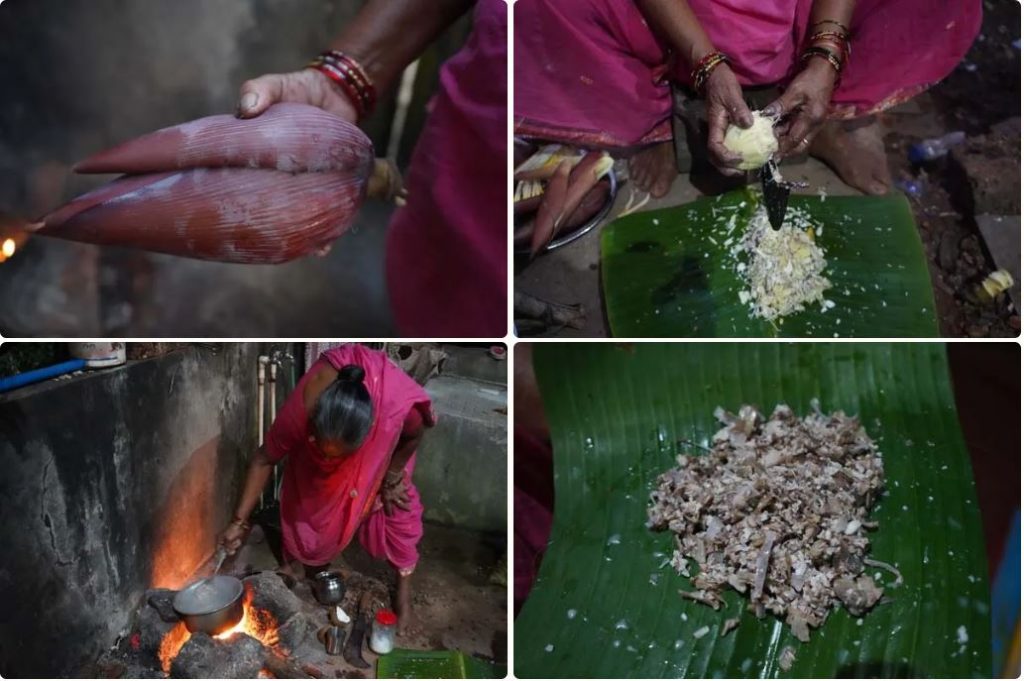
“Boni Bhaji” is a typical traditional dish of Goan tribal cuisine.“Boni” is one of the flowering parts of the banana tree. This “boni bhaji” has many medicinal values, and its consumption is also good for kidney stone patients. Boni bhaji preparation should start one day before or 4 to 5 hours before. Especially during the night time it is cut and chopped into small pieces and kept in water. If one keeps it dry, without adding water, it will turn grey.
Ingredients
• 1 medium size boni chopped; ½ grated coconut; 1 onion finely chopped; 2 glasses of water; salt to taste.
Preparation:
— Cut and chop boni into small pieces and keep in water for 4-5 hrs.
—Take a vessel, add water, and chopped “boni bhaji”and cook on a mud challah.
—Keep for 8-10 min on medium flame and stir it in between.
—Later add grated coconut, chopped onion, and salt as per the taste.
—After adding all these ingredients, keep it for another 5 min for cooking on low flame.
—Overall, it takes 15 -20 min to complete cooking “boni bhaji.”
ALVA YETT

Tero, also known as allu and arvi, is a popular root vegetable, which is rich in starch. Alva yettis made of the stem of the arvi plant, that is allu leaves (tropical vegetables). This plant grows in both wet and dry places and is botanically named Colocasia esculenta. This planthas huge heart-shaped leaves, which look like an elephant’s ear. Tero are used as vegetables for their corms, leaves, stems and petioles. It is grown in the rainy season during July and is available in November. Most of the tribal people cut the stem and dry it for further use. Alva yett is served with rice or bhakri.
Ingredients:
• 10 Alva yet; 5 suki mirsang (red chili); 2 tablespoon haldi powder (turmeric); 3 tablespoon suki kothimbir (coriander seeds);
• nall (coconut) 1 wolle (half a coconut); kano (onion) 1 fine chopped; chavlo (kidney beans) 2 handful.
Preparation:
—First, collect Alva yettfrom the cultivated land
— Peel and cut into small cubes
—Boil some water, addchavlo, and boil for 10 minutes
—Then add cut alva yet till it boils
—Make a gravy called “Allen” (uncooked curry) with chilly, onion, coriander, coconut, and turmeric
—After boilingalva yet, add uncooked curry, and add salt to taste
—Cook for 15 minutes till the mixture thickens
—Alava yett is ready to serve
FHATERPHODI PANNACHYO PATHOLYO
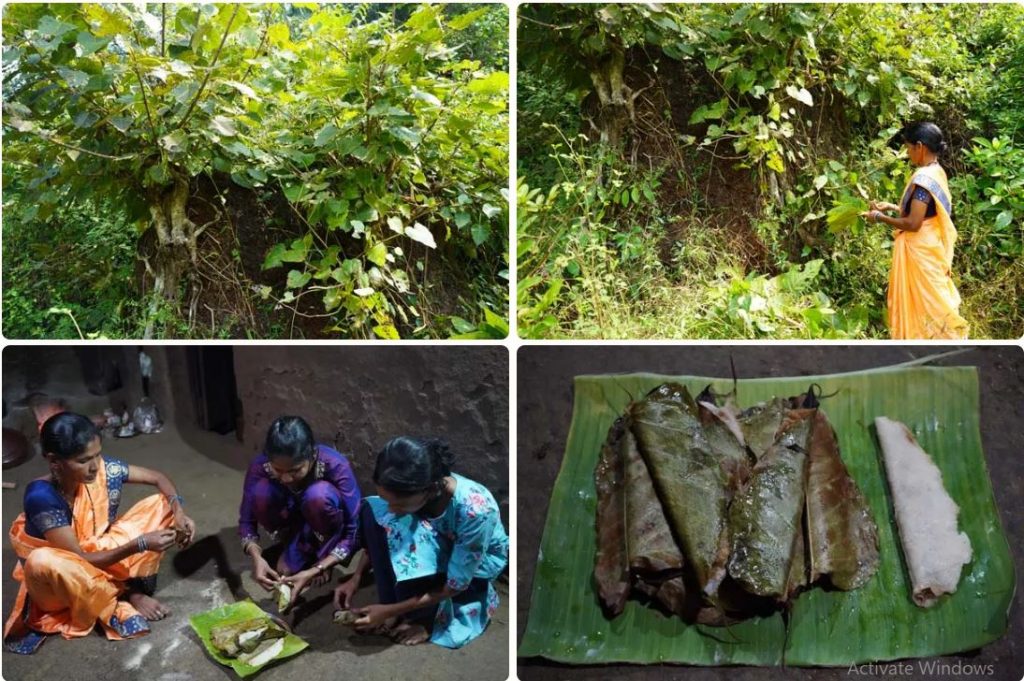
Patholyo is a unique, soft and aromatic steamed sweet made by spreading rice paste on leaves. It is popularly eaten during monsoon time along with tea. The leaves used belong to a tree that grows only on or between rocks and is called “fhatherfhodo” and the leaves are called “fhaterphodhi panna.”These leaves look similar to the leaves of the banyan tree. It is a seasonal tree found in forest land where there are only rocks.
Fhaterphodhi Pannacho Pathalyo is prepared during a religious occasion called “Sala Amas.” It is also a medicinal plant since the juice of its root helps control kidney stone formation. Similarly, patholyoare made on different religious occasions in different villages using leaves like kesri pan (leaves), haldi pan, mauli pan and kelli pan.
Ingredients
Adjust Servings
• Fhaterphodi panna (leaves) – 20
• Ukde tandul (parboil rice) – 1 Atiyo (1 kg)
• Nall (Coconut) -2
• God (Jaggery)– 2 handfuls
• Nalla cottyo (Coconut shell) – 5
• Kelli panna (Banana leaves) – 2
• Udok (Water)- 6 pot
Procedure
— Soak Ukdetandulfor at least 12 hours
— Wash the rice and grind it with traditional Ragdo to make dry flour
— Then make a Chunn using jaggery and grated coconut and mix it well
—Wash the leaves
—Take the rice batter and apply it by hand on fhaterphodi leaves
—After applying, stuff the Chunn over the leaf. Fold the leaf in half to enclose the chunn
—In a pot,place the coconut shell with banana leavesand keep Patholyo in the pot to boil
—It takes 10 minutes to boil and the color of leaves changes to brown when cooked
— The Patholyo is ready to be served
BONKALYA BHAJI (WILD VEGETABLE)
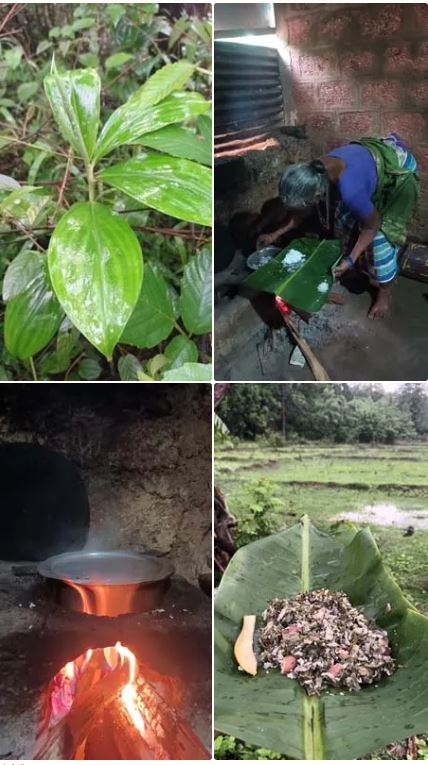
Bonkalo is a wild vegetable and its bhaji is made of the vegetable’s leaf. This bhaji is prepared from June to July, the starting month of the monsoon. This bhaji has medicinal value and is good for diabetic patients to control their sugar levels.
Ingredients
Bonkolo leaf; 1 bowl grated coconut; 2-3 green chillies; 2 onions; 1 glass water; salt as per taste.
Preparation:
—First, add water to a vessel and keep it on the mud chulha.
—After the water boils, add chopped pieces of jackfruit seeds.
—Let the jackfruit seeds boil for at least 4-5 min and add the finely chopped bonkolo leaves, onion, and green chillies. Mix thoroughly.
—After adding all the ingredients, shut the vessel with a lid and let it cook for a few minutes.
—After 10-15 minutes, add grated coconut and salt. Mix it again thoroughly and let it cook until all the water in the vessel evaporates.
—Cook for 25-30 minutes. The bhaji is ready to serve
AMSOL
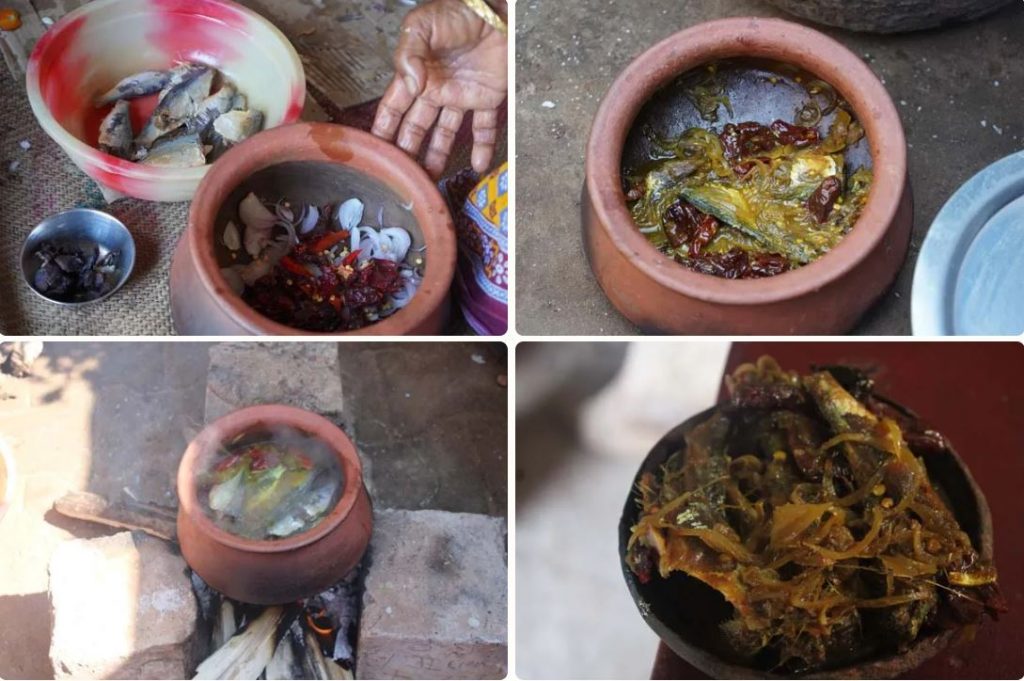
Amsol is a non-vegetarian dish prepared by the Christian Gawda community. It can be prepared at any time and is quick and easy to make, serve with rice at meal time.
Ingredients
Adjust Servings
• Sukke / khare nuste (dry fish) – peddi or bangda (mackerel)- 10; kano (onion) 2, fine chopped; harvi mirsang (green chilly) 1 roughly cut; bhindachya solache udok (juice of kokum) 1 tsp; khobrel tel (coconut oil) 2 tsp; sugar 1 tsp; haldi powder (turmeric) 2 tsp; salt to taste.
Preparation:
— First, take dry fish and soak for at least 10 minutes to remove khavsa (scales).
— Then clean the fish.
— Cut onion and chilli.
—Take a vessel and put all the ingredients along with cleaned fish.
—Then mix properly.
— Boil for 15 minutes.
—Amsol is ready to serve
BINDDA SOLA (KOKUM PRESERVATION)
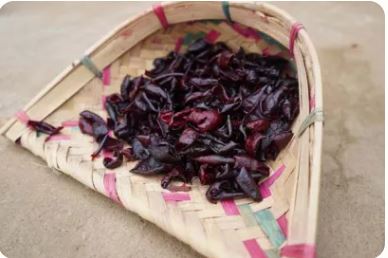
A mainstay of Goan cuisine is kokum (Garcinia indica), a tropical fruit indigenous to India’s Western Ghats. Kokum is a seasonal fruit which flowers from March to May. Kokum terminals are rich in antioxidants and other beneficial compounds. Goan tribal cuisine has long preserved this portion of the kokum using traditional methods, exhibiting their enduring wisdom and environmentally sound behaviour.
Harvesting the kokum terminals:
- Kokum terminals are typically harvested during the fruit-bearing season when the fruit is completely ripe.
- The kokum fruit is collected and brought home for further process.
- The terminals, which are the stem like structures supporting the fruit clusters, are carefully cut and cleaned.
- Separate the seeds and peels of the kokum as well as the kokum vinegar, also known as “Aagal”.
- The seeds of the kokum are placed in an open place for drying in sunlight. Later, these kokum seeds are used to make an oil known as “bhindel” in Konkani.
- The kokum peels too are kept in sunlight for 7-8 days to completely dry them.
- After a few days, the dry kokum rinds are mixed with “aagal” and are kept in sunlight to dry for a few hours.
- Once dried, they are stored in airtight containers, to protect from moisture
BHIKANA CHUTNEY (JACKFRUIT SEED CHUTNEY)
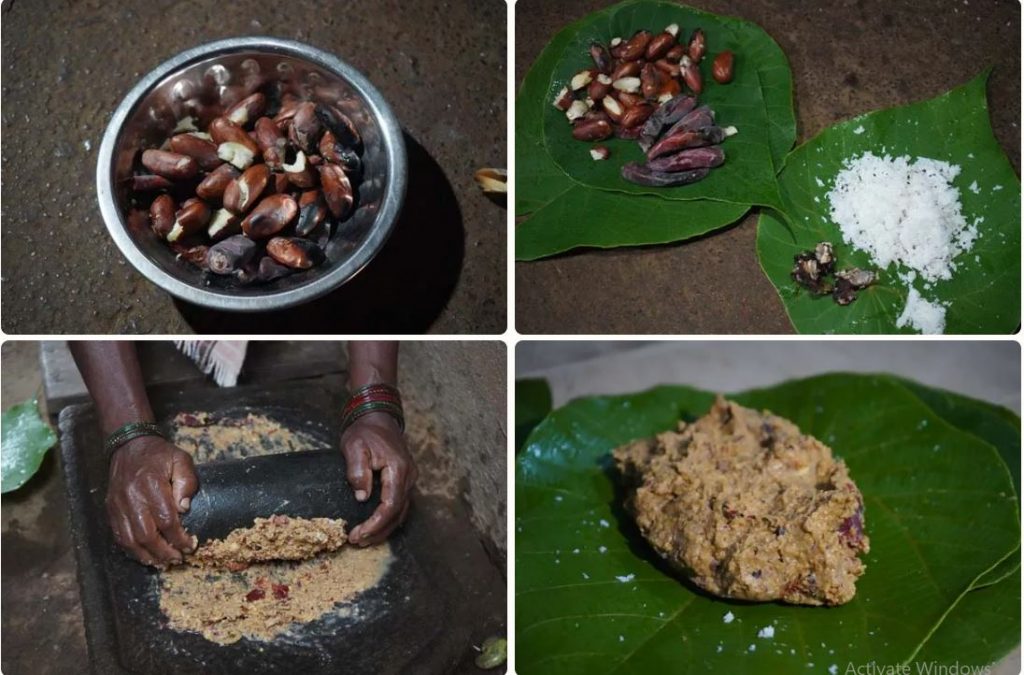
Often overlooked, the seeds of the majestic jackfruit are a treasure trove of nutrients. Goan tribal communities have, for generations, transformed these seeds into a flavorful and nutritious chutney. This recipe is a homage to their culinary wisdom. The chutney is a perfect blend of tangy, spicy and earthy flavors, making it a unique accompaniment to various Goan dishes.
Ingredients
• 15-20 jackfruit seeds; 4-5 red chillies; 1 grated coconut; tamarind (aamtaan), as per taste; 1 glass water; salt, as required
Preparation:
— Begin by poking small holes in the jackfruit seeds before placing it on burning coals to roast them.
— Remove the roasted seeds and next roast red chillies on the burning coal.
— Clean the jackfruit seeds by removing its skins.
— Place all and place them on the grinding stone. Use a little water and grind to a paste.
— The delicious and simple chutney is ready to eat with bhakari or steamed rice or as desired.
AAKUR / ANKUR
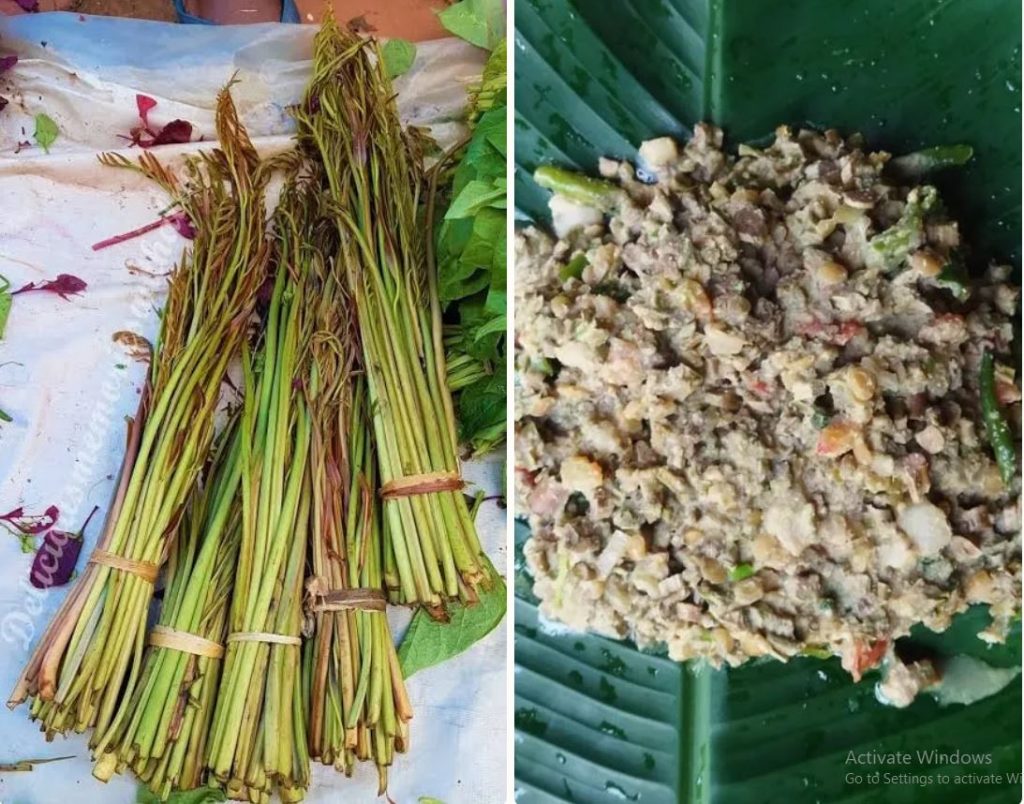
Aakur is monsoon time special edible ferns that grow in marshy mangrove areas. The scientific name of Aakur is Acrostichum. It is one of the delicacies that Goans have believed are essential to consume at least once during the monsoon. As aakur belongs to the fern family, it can be cultivated artificially, just as we do with ornamental ferns used in flower bouquets.The tree of akkuris called “akkrin” and the komb (sprout) is known as akkur. In Konkani, akkur means the tender new sprouts of a plant and give the vegetables its name. Just as the name suggests these are tender shoots of the fern that are edible. They are long, and slender and are grown naturally in open areas which are favoured by nature conditions. People gather these tender shoots of the brown ferns which have a tinge of red for cooking. Many dishes may be prepared with akkur such as bhaji, curry and it is served with rice or bread.
Aakur is a local vegetable that is seasonal and is mainly available during monsoons. It has to be prepared and consumed fresh just like green leafy vegetables and hence is available for a short period of time. Collecting this edible fern is an art since the person needs to go to marshy areas and select just the right sorts of ferns. This vegetable is a rich source of high quantity of fiber, vitamins, and minerals.
Ingredients
• Akkur- 4 handful, fined chopped; chonne (white peas) 2 handful; nall (coconut) 1; kano (onion)1 fine chopped; harvi mirsang (green chilly) 5 cut pieces; haldi powder (turmeric); ½ tsp; batat (potatoes) 1 cut; mit (salt) to taste.
Preparation:
—First, wash akkur thoroughly.
—Then add finely chopped akkur, cut chili, onions and potatoes.
— Boil water in a vessel and add chonne and fined chopped akkur and cover it with a lid.
— Cook mixture for 20 minutes.
— Add cut chili, onion, potatoes.
— Grate coconut, coriander, onion and turmeric with a grinding stone for curry, cook this curry which is called as “alen.”
— Add curry to mixture and stir in properly.
— In 30 minutes akkur is ready to serve.
ATTOL
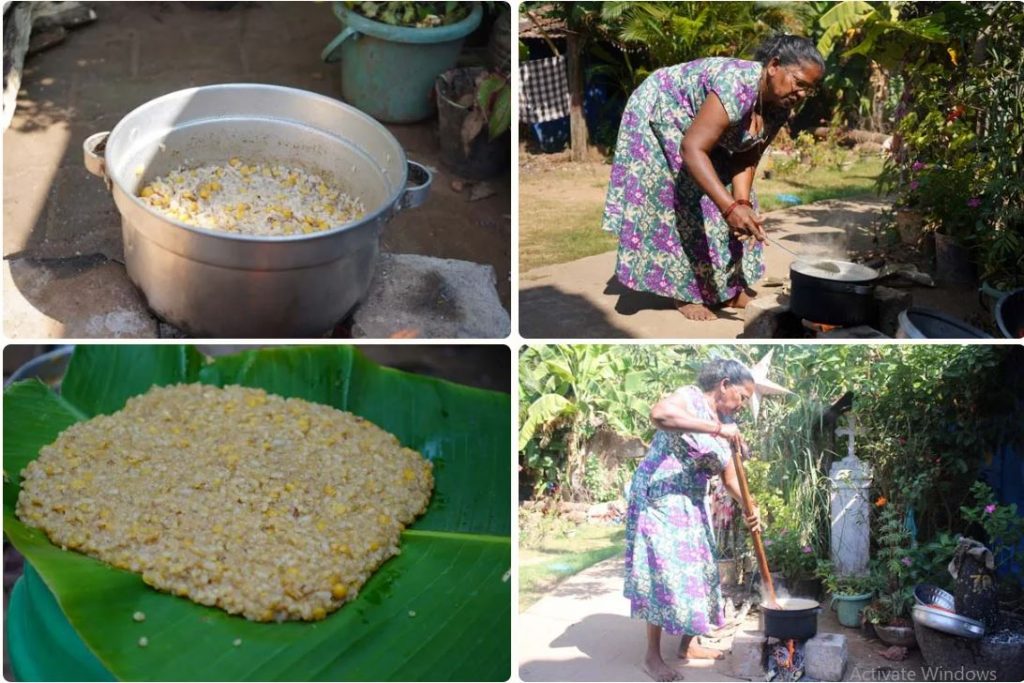
Attol means to thicken oratop (dhat javop). It is a sweet dish that is prepared by the Christian Gawda community. It is usually served after lunch instead of dessert, attol is distributed to everyone.
Ingredients
• Ukde tandul (parboil rice) 1 glass (400 gram); channa dal 1 handful; nallacho ros (coconut milk) 1; god (jaggery) 2 handfuls (½ kg); mit (salt) to taste.
Preparation:
— Cook washed rice and dal together for 10 minutes.
— Grind coconut and squeeze out the thick juice to get coconut milk.
— Then add coconut milk, jaggery, and salt and stir well till the mixture thickens.
— Then remove and place this mixture on banana leaves and spread.
— Keep 4-5 hours to cool.
— Cut into small pieces and serve.
AMIL

Amil is a curry prepared by the tribal community people and is made of millets. Tribal communities’ people cultivated their own “Gonyache Kamat”, or millet cultivation in Konkani, and sustained their life. Amil is usually served with rice and is a staple food of tribal people. Gonnye, also called ragi (finger millet) and scientifically Eleusine coracana, it is high in calcium, iron and fibre. Ragi confers valuable health benefits such as enhancing digestion, reducing the risk of heart disease, slowing down aging, and managing diabetes. Ragi is indeed a superfood, offering a multitude of essential nutrients for the growth and development of organs. The bhakrieaten with amil is made of “gonne.”
Millets (gonnye) grow after the first monsoon showers. To grow these millets, the tribal people first cleaned the area to be cultivated among the hilly regions and harvested the crops after monsoon in bundles of gonne called “posva.” These were then dried for 3-4 days to make gonne. The gonne were then made into “pit” by grinding it to flour using the traditional grinding stone, datem. It is stored for long periods and used to make gonnyacha pitache amot, bhakri and satv. The tribal people say that consuming amil early in the morning satiates their hunger for a longer period of time. There are two types of amil — one is kusok ghatilli amili, amil kept for fermentation, the second type is without fermentation.
Ingredients:
• Gonnyache pit – (ragi flour)2 handfuls (300 gram); salt -2 tsp; water 3 small pots.
Preparation:
— Washed gonne thoroughly.
— Grind and make flour.
— Take flour, add water and stir well in liquid form.
— Take a mud pot and put gonnyache pit (flour).
— Keep aside for 12 hours for fermentation or “kusok ghalop.”
— Soak ragi in a pot of boiling water.
— Add salt, mix it well, and boil it until the mixture becomes thick.
—Amil is ready to serve.
AMOLLO
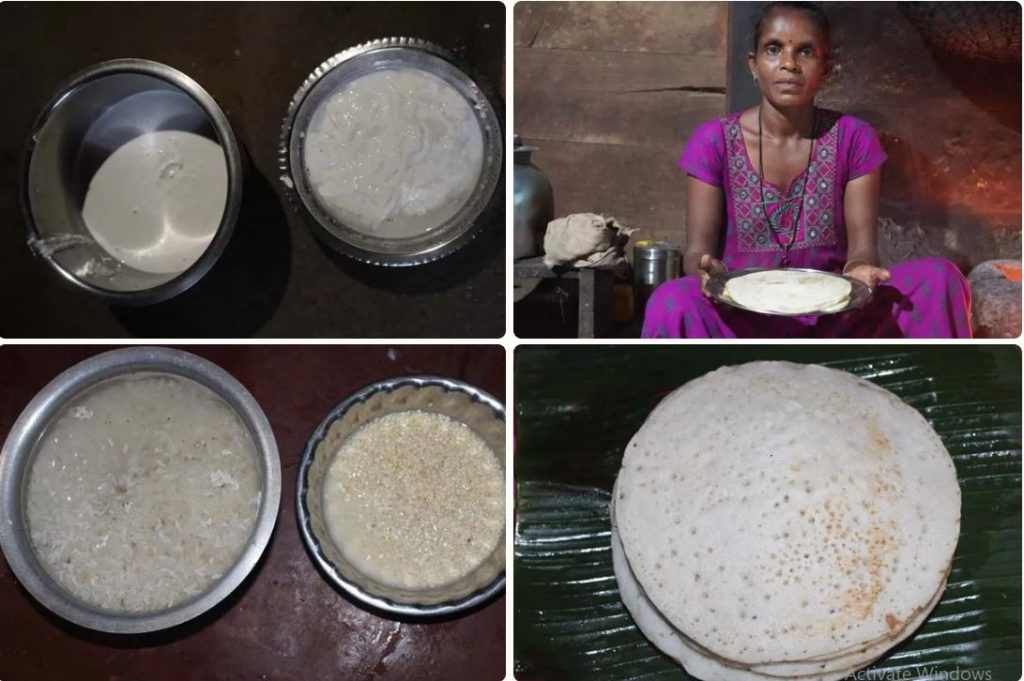
Amollyo is a bhakri which is made only on the religious occasion of “Ghudullya Parab” (Ghudulo).
The tribal community people celebrated tribal religious festivals in the main village’s house called “Ghudullo.” During this festival, married girls come to their maternal house and stay for “Apone”, which is the period from Naya Parab till Gudulo. During this festival, newly married girls take one coconut and one amoli (bhakri)and go to the house of the village’s headperson. Then they bring spring water from their sacred place. This water is collected in 4-5 alluleaves (tropical leaves),which are large heart-shaped leaves, and tied tightly with the help of “vayo” which is one type of rope. The leaves containing water are then tied on the main door of the Ghudulloor the house of the village’s head person. The bhakri and coconut are cut into small pieces and distributed to everyone and The gathered people then hold the water in their mouths and return to their homes.
Ingredients:
• Ukde tandul 2 atiye(1kg); udda dal 3 hand full; salt to taste.
Preparation:
— Soak the rice in a deep bowl overnight in water.
— Wash and grind with jaggery and rice.
— Cover the flour with a lid and keep aside for 12 hours for fermenting.
— The amollyo is made on a “tovo” (griddle) on the traditional stove by applying some oil to the tovo.
— Put around 3 ladles of flour on the tova in a round shape, cover it, and cook on a low flame.
— After 5 minutes, removethe bhakri with the help of a “arro” or ladle.
— Amollyo is ready to serve.














